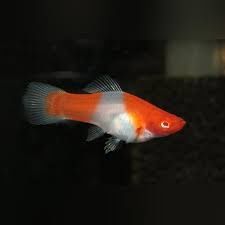Kohaku Swordtail
Kohaku Swordtail is a striking color variety of the Swordtail (Xiphophorus hellerii), named after the famous Japanese koi coloration: white body with vibrant red-orange patches. Kohaku Swordtails are hardy, active, and peaceful freshwater fish that thrive in well-maintained community tanks.
Kohaku Swordtail – Complete Care Guide
Quick Facts
-
Scientific Name: Xiphophorus hellerii
-
Common Name: Kohaku Swordtail
-
Size: 4–5 inches (10–13 cm), males usually smaller than females
-
Lifespan: 3–5 years
-
Temperament: Peaceful, active, mildly territorial males
-
Swimming Level: Mid to top
-
Care Level: Easy
-
Origin: Central America (wild type); Kohaku = selectively bred variety
Tank Requirements
| Requirement | Ideal |
|---|---|
| Tank size | 20 gallons minimum (30+ gallons for groups) |
| Temperature | 22–28°C (72–82°F) |
| pH | 7.0–8.3 |
| Hardness | 10–30 dGH (moderate to hard water) |
| Water type | Freshwater (optional: slightly brackish) |
| Filtration | Moderate; clean, well-oxygenated water |
| Substrate | Gravel or sand |
| Decor | Live or artificial plants, rocks, open swimming areas |
Tip: Males have a long sword-like tail extension; provide space for swimming and showing off.
️ Diet
Omnivore – Easy to feed
Feed a mix of:
-
High-quality flakes or micro-pellets (color-enhancing varieties are ideal)
-
Blanched veggies (zucchini, spinach, cucumber)
-
Frozen/live foods (brine shrimp, bloodworms, daphnia)
-
Occasional algae wafers or spirulina for fiber
Avoid overfeeding — feed small amounts 1–2 times daily.
Behavior & Tankmates
-
Peaceful and social
-
Active swimmers, especially males
-
Keep in groups of 3+ to reduce aggression among males
✅ Good Tankmates:
-
Guppies, Mollies, Platies
-
Tetras (non-nippy types)
-
Corydoras
-
Rasboras
-
Gouramis (dwarf varieties)
-
Peaceful barbs (like cherry barbs)
-
Shrimp and snails (may chase babies)
⚠️ Avoid:
-
Betta males (due to similar fin shape)
-
Aggressive cichlids
-
Tiger barbs (fin nippers)
Breeding Kohaku Swordtails
-
Livebearers: Females give birth to free-swimming fry
-
Easy to breed in a mixed group (1 male : 2–3 females)
-
Separate breeding tank or heavily planted tank helps protect fry
-
Adults may eat fry — add floating plants or use breeding boxes
Fun Fact: Female Swordtails can store sperm and give birth multiple times after mating just once!
Water Maintenance
-
Weekly water changes (20–30%)
-
Stable, clean water prevents disease and stress
-
Use a test kit to monitor pH, ammonia, nitrite, nitrate
⚠️ Common Health Issues
| Problem | Cause | Solution |
|---|---|---|
| Fin rot | Poor water quality | Improve filtration, medicate if needed |
| Ich (white spots) | Stress, new tankmates | Quarantine newcomers, raise temp slightly during treatment |
| Algae on fins | Too much light or excess nutrients | Balance feeding and light cycle |
✅ Kohaku Swordtail Care Summary
| Feature | Value |
|---|---|
| Size | 4–5 inches |
| Lifespan | 3–5 years |
| Temperament | Peaceful, active |
| Water Temp | 22–28°C (72–82°F) |
| pH | 7.0–8.3 |
| Tank Size | 20+ gallons |
| Diet | Omnivorous |
| Breeding | Easy livebearer |

